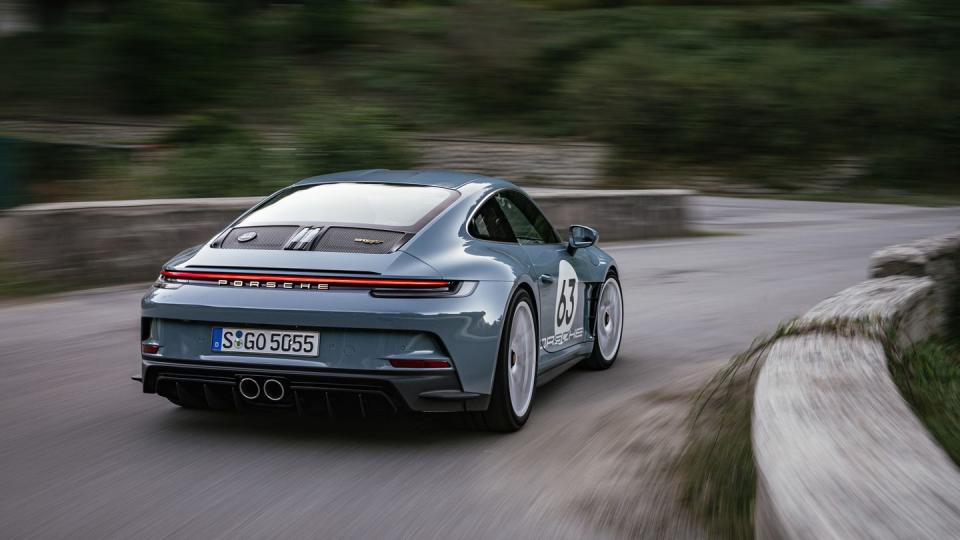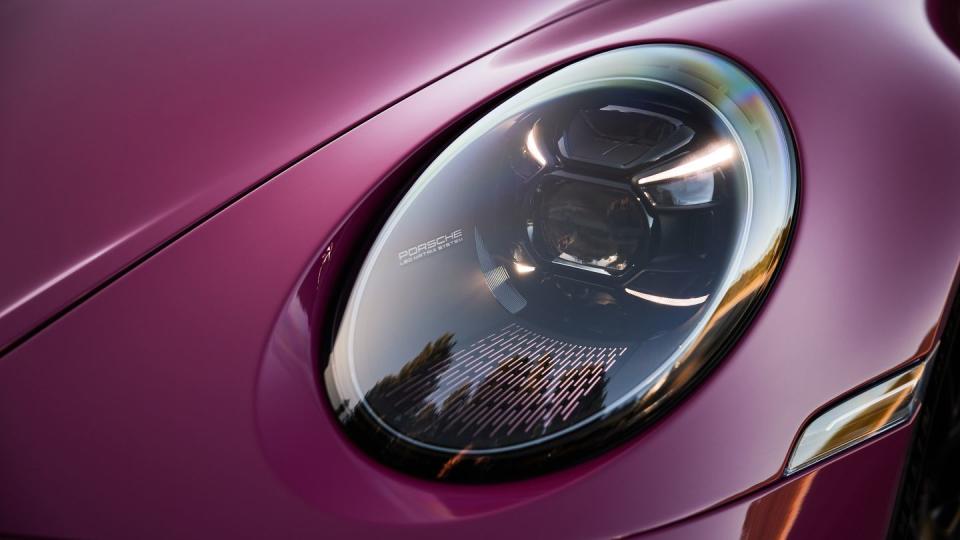2024 Porsche 911 S/T May Cause Buyer's Remorse in 911 GT3 and GT3 Touring Owners
Don't drive the Porsche 911 S/T. That public-service announcement is for the owners of the 911 GT3 and GT3 Touring, two sports cars closely related to the new S/T. Owners of those cars should be delighted with the steering, brakes, handling, and performance of their cars and will remain so provided they don't get a chance in one of the 1963 examples of the 911 S/T that Porsche will produce.
The 911 S/T is the latest creation from the Porsche GT department (the engineering team whose resume includes heavy hitters such as the GT3, GT3 RS, Boxster Spyder RS, and Cayman GT4 RS). In all but name, the S/T is the long-awaited follow-up to the lightweight, manual-only 911 R that put a chef's kiss on the last (991.2) 911 generation. Presumably to keep the last R a distinct once-in-a-generation thing, Porsche didn't christen the new car the R. Instead, it wears the S/T badge, a link to a limited-production race-car version of the 911 S from the late 1960s/early 1970s.
The new S/T isn't a race car or even a track car. It's a road-focused 911 with a lot of parts from the GT3 and the GT3 RS. A short-throw six-speed manual is the sole transmission choice, and tucked behind the rear wheels is the GT3 RS's naturally aspirated 4.0-liter flat-six. The S/T leaves the engine unaltered—output remains at 518 horsepower at 8500 rpm—but in the interest of quickening throttle response, the weight of the clutch and flywheel are halved, resulting in a weight reduction of 23 pounds. Let's just say that the C/D staff didn't think that this zingy engine needed faster responses. We joked that the regular GT3 used a fidget spinner as a flywheel; we'll amend that to say that the S/T's tachometer is like a fidget spinner. Taking the mass out of the flywheel does result in a rattling sound from the clutch and engine from idle to about 2900 rpm.
The solution is to keep the revs up, which is easier thanks to a shorter 4.30-to-1 final-drive gearing that replaces the GT3's 3.96 ratio. The speeds in gears drop, and responsiveness rises. Whereas second gear is good to 80 mph in the GT3, it maxes out at 72 mph in the S/T. Porsche claims 60 mph will arrive in 3.5 seconds, two-tenths quicker than the company's claim for the 502-hp manual GT3. Our test team managed a 3.3-second run to 60 with a GT3 manual, so expect the S/T to knock a tenth or two off that time.

The weight savings don't stop at the flywheel and clutch. The carbon-fiber doors and roof are GT3 RS parts, the carbon-fiber front fenders are unique to the S/T, and the Touring's carbon-fiber hood caps the spacious front trunk. A thinner windshield sheds a few pounds. Magnesium wheels and carbon-ceramic brakes are standard. A 6.6-pound lighter battery is fitted, the carpets go on a 4.4-pound diet, and the carbon-fiber rear anti-roll bar from the GT3 RS's Weissach package shaves another 4.4 pounds. To shed 14.3 pounds and to purge technology from the chassis, the rear-wheel-steering system is axed. Total it all up, and Porsche says the S/T comes in at 84 pounds lighter than the lightest 911 GT3 Touring. We won't be able to weigh an S/T until we have one in the States, but based on our test numbers for a manual GT3, we'll play carnival barker and guess it weighs around 3100 pounds.

According to the engineers who developed the S/T, removing the rear steering initially made a mess of the car's handling. To set it right, a slower rack with a 15.0:1 ratio replaces the GT3's 14.2:1 unit, the electric assist was extensively retuned, and the mechanical limited-slip differential locks more casually. The result is a pure, uncut steering feel. Bend the S/T hard into a corner, and the tugs and vibrations tell a story of the changing grip of the road surface and the stress placed upon the standard Michelin Pilot Cup 2 tires. The limits are high, but the S/T normalizes 1-g cornering by coordinating chassis and steering actions in a secure and easy way. Porsche confidently let us have a go in a GT3 Touring after driving the S/T, and it couldn't quite match the fluidity and sensations coming through the S/T's wheel.
Driving a Touring makes the S/T's chassis differences apparent. On choppy asphalt, the Touring tosses and skips over sharp impacts whereas the S/T smothers them. Springs and dampers are identical between the two cars—the difference is in the damper tuning. The S/T's are slightly more compliant and dull sharp impacts. There's no getting around the stiff spring rates, so this isn't a cushy ride, but it's a little more friendly than the Touring's.

Driving both cars reveals the little things about the GT3 and GT3 Touring that bothered the GT development engineers. While nearly all the changes seek to distill the GT3's already-pure driving experience, one alteration points to the obsessive nature of the crew that made this car. The team didn't like the way the retractable spoiler on the current 911 rises awkwardly into the wind, leaving the rear end looking like a Transformer mid-transformation. So, the S/T gets a subtle Gurney flap on the edge of its retractable spoiler, which allows the spoiler to rise at 74 mph rather than 56 mph and at a less jaunty angle.
Upgrading to the S/T over a GT3 Touring requires a lot more cash, and that's if you can secure an order for one. The S/T starts at $291,650, over $100,000 more than the Touring. Rare Porsches are always expensive, but the upcharge brings a lot of small, well-placed tweaks that improve the driving experience. But, if you never drive it, you'll never know what you're missing out on.
You Might Also Like

 Yahoo Autos
Yahoo Autos 